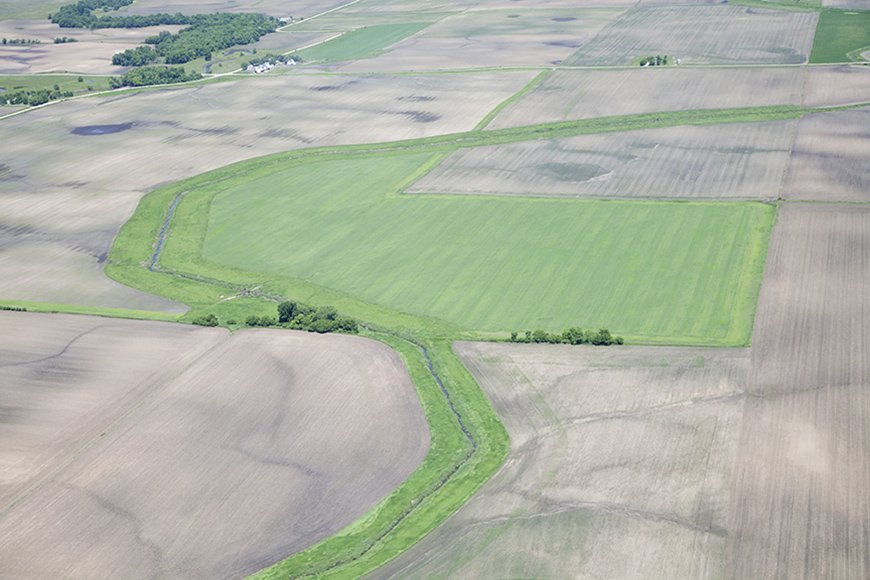Five Things Farmers Are Doing to Protect Waterways

August is designated as Water Quality Month, and it’s a time to recognize what farmers are doing to keep our water clean. Here are five practices that some farmers are already implementing.
Conservation buffers
Conservation buffers are commonly seen in fields to prevent sediment, nutrients and pesticides from reaching water bodies. Examples of effective conservation buffers include filter strips, grassed waterways and field borders. The U.S. Natural Resources Conservation Service estimates that properly installed and maintained buffers have the capacity to remove up to 50 percent nutrients and pesticides, and 75 percent or more sediment compared to a non-buffered field.
Cover crops
Cover crops are a growing trend among farmers who are looking for ways to reduce erosion and improve soil health. Cover crops help retain nutrients in the soil and can help with water-holding capacity. The University of Missouri reports that cover crops may reduce soil erosion by 90 percent and pesticide and nutrient runoff by 50 percent.
Conservation tillage
The main goal of conservation tillage is to keep soil in fields instead of allowing it to move off-site to nearby water bodies. Any tillage system that leaves at least 30 percent of the soil surface covered with crop residue after planting to reduce soil erosion is considered conservation tillage.
Precision agriculture tools and technology
From tractors with GPS to prescription planting, farmers today have more accurate and efficient ways to do business. Precision technology allows farmers to strategically target inputs where they’re needed at the correct time. Technology can help diagnose in-season plant stresses, and treatments can be made exactly when and where they are needed, reducing the runoff potential of nutrients and pesticides that could impair waterways.
Bioreactors
Bioreactors are a relatively new and progressive tactic being explored by some farmers to help protect waterways. The premise is fairly simple: divert nutrient-rich drainage water from tile lines to a wood-chip-filled basin at the edge of a field. Native soil bacteria within the basin use the carbon from the wood chips as food and nitrogen from the wastewater for respiration. The bacteria convert runoff nitrate to a gaseous form that returns to the atmosphere. Iowa State University reports that research shows bioreactors have the potential to remove 15 to 60 percent of the nitrate load in tile lines per year. Some states offer financial assistance for the installation of bioreactors.
These are just some of the ways that farmers are using old and new methods to protect waterways. Research shows that even though yields have increased over the years, water pollution from agricultural activities has decreased due to diligent conservation practices.
Conservation buffers
Conservation buffers are commonly seen in fields to prevent sediment, nutrients and pesticides from reaching water bodies. Examples of effective conservation buffers include filter strips, grassed waterways and field borders. The U.S. Natural Resources Conservation Service estimates that properly installed and maintained buffers have the capacity to remove up to 50 percent nutrients and pesticides, and 75 percent or more sediment compared to a non-buffered field.
Cover crops
Cover crops are a growing trend among farmers who are looking for ways to reduce erosion and improve soil health. Cover crops help retain nutrients in the soil and can help with water-holding capacity. The University of Missouri reports that cover crops may reduce soil erosion by 90 percent and pesticide and nutrient runoff by 50 percent.
Conservation tillage
The main goal of conservation tillage is to keep soil in fields instead of allowing it to move off-site to nearby water bodies. Any tillage system that leaves at least 30 percent of the soil surface covered with crop residue after planting to reduce soil erosion is considered conservation tillage.
Precision agriculture tools and technology
From tractors with GPS to prescription planting, farmers today have more accurate and efficient ways to do business. Precision technology allows farmers to strategically target inputs where they’re needed at the correct time. Technology can help diagnose in-season plant stresses, and treatments can be made exactly when and where they are needed, reducing the runoff potential of nutrients and pesticides that could impair waterways.
Bioreactors
Bioreactors are a relatively new and progressive tactic being explored by some farmers to help protect waterways. The premise is fairly simple: divert nutrient-rich drainage water from tile lines to a wood-chip-filled basin at the edge of a field. Native soil bacteria within the basin use the carbon from the wood chips as food and nitrogen from the wastewater for respiration. The bacteria convert runoff nitrate to a gaseous form that returns to the atmosphere. Iowa State University reports that research shows bioreactors have the potential to remove 15 to 60 percent of the nitrate load in tile lines per year. Some states offer financial assistance for the installation of bioreactors.
These are just some of the ways that farmers are using old and new methods to protect waterways. Research shows that even though yields have increased over the years, water pollution from agricultural activities has decreased due to diligent conservation practices.


